春节的来历,习俗的英文介绍
- 格式:doc
- 大小:23.00 KB
- 文档页数:3
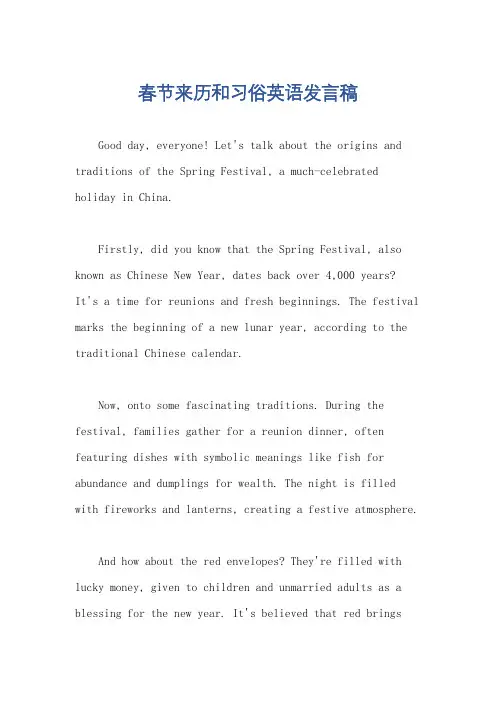
春节来历和习俗英语发言稿Good day, everyone! Let's talk about the origins and traditions of the Spring Festival, a much-celebrated holiday in China.Firstly, did you know that the Spring Festival, also known as Chinese New Year, dates back over 4,000 years?It's a time for reunions and fresh beginnings. The festival marks the beginning of a new lunar year, according to the traditional Chinese calendar.Now, onto some fascinating traditions. During the festival, families gather for a reunion dinner, often featuring dishes with symbolic meanings like fish for abundance and dumplings for wealth. The night is filled with fireworks and lanterns, creating a festive atmosphere.And how about the red envelopes? They're filled with lucky money, given to children and unmarried adults as a blessing for the new year. It's believed that red bringsgood luck and wards off evil spirits.Oh, and let's not forget the dragon dances! Theselively performances are a joy to watch, symbolizing the power of the dragon, which in Chinese culture, represents prosperity and good fortune.Lastly, the festival is a time for cleaning and renewal. Homes are thoroughly cleaned to sweep away bad luck and make way for positive energy in the new year.。
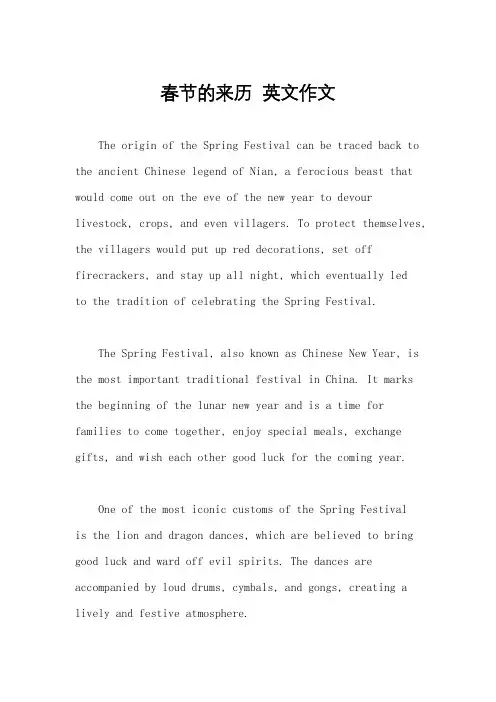
春节的来历英文作文The origin of the Spring Festival can be traced back to the ancient Chinese legend of Nian, a ferocious beast that would come out on the eve of the new year to devour livestock, crops, and even villagers. To protect themselves, the villagers would put up red decorations, set off firecrackers, and stay up all night, which eventually ledto the tradition of celebrating the Spring Festival.The Spring Festival, also known as Chinese New Year, is the most important traditional festival in China. It marks the beginning of the lunar new year and is a time for families to come together, enjoy special meals, exchange gifts, and wish each other good luck for the coming year.One of the most iconic customs of the Spring Festivalis the lion and dragon dances, which are believed to bring good luck and ward off evil spirits. The dances are accompanied by loud drums, cymbals, and gongs, creating a lively and festive atmosphere.Red is the dominant color of the Spring Festival, as it is believed to symbolize good luck and happiness. People decorate their homes with red lanterns, couplets, and paper cutouts, and wear new clothes in red to welcome the new year.During the Spring Festival, people also visit temples to pray for good fortune, health, and prosperity. They burn incense, make offerings to the gods, and seek blessings for the coming year.The Spring Festival is a time of joy, reunion, and renewal. It is a time to reflect on the past year, let go of any negative energy, and look forward to new beginnings and opportunities in the year ahead.。
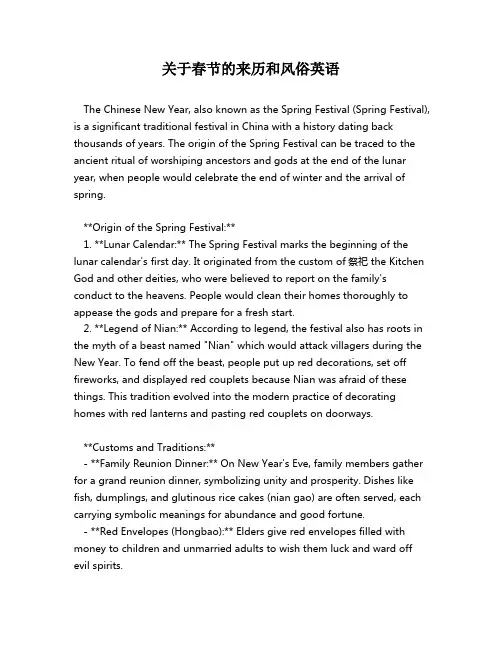
关于春节的来历和风俗英语The Chinese New Year, also known as the Spring Festival (Spring Festival), is a significant traditional festival in China with a history dating back thousands of years. The origin of the Spring Festival can be traced to the ancient ritual of worshiping ancestors and gods at the end of the lunar year, when people would celebrate the end of winter and the arrival of spring.**Origin of the Spring Festival:**1. **Lunar Calendar:** The Spring Festival marks the beginning of the lunar calendar's first day. It originated from the custom of祭祀 the Kitchen God and other deities, who were believed to report on the family's conduct to the heavens. People would clean their homes thoroughly to appease the gods and prepare for a fresh start.2. **Legend of Nian:** According to legend, the festival also has roots in the myth of a beast named "Nian" which would attack villagers during the New Year. To fend off the beast, people put up red decorations, set off fireworks, and displayed red couplets because Nian was afraid of these things. This tradition evolved into the modern practice of decorating homes with red lanterns and pasting red couplets on doorways.**Customs and Traditions:**- **Family Reunion Dinner:** On New Year's Eve, family members gather for a grand reunion dinner, symbolizing unity and prosperity. Dishes like fish, dumplings, and glutinous rice cakes (nian gao) are often served, each carrying symbolic meanings for abundance and good fortune.- **Red Envelopes (Hongbao):** Elders give red envelopes filled with money to children and unmarried adults to wish them luck and ward off evil spirits.- **Cleaning and Decorating:** Before the New Year, houses are cleaned thoroughly to sweep away bad luck and adorned with red decorations, paper cutouts, and auspicious phrases.- **Setting Off Fireworks and Firecrackers:** Originally used to scare off evil spirits and bring good luck, this tradition is still observed in many parts of China although restrictions may apply due to environmental concerns. - **Lantern Festival and Dragon/Lion Dances:** The celebrations culminate with the Lantern Festival on the 15th day of the lunar new year, featuring colorful lantern displays and lively dragon or lion dances performed to bring good luck and happiness.- **Visiting Relatives and Friends:** During the festival period, it is customary to visit relatives and friends, exchanging greetings and well-wishes for the upcoming year.These customs and traditions vary regionally within China but share a common theme of renewal, family togetherness, and hope for a successful and prosperous new year.。
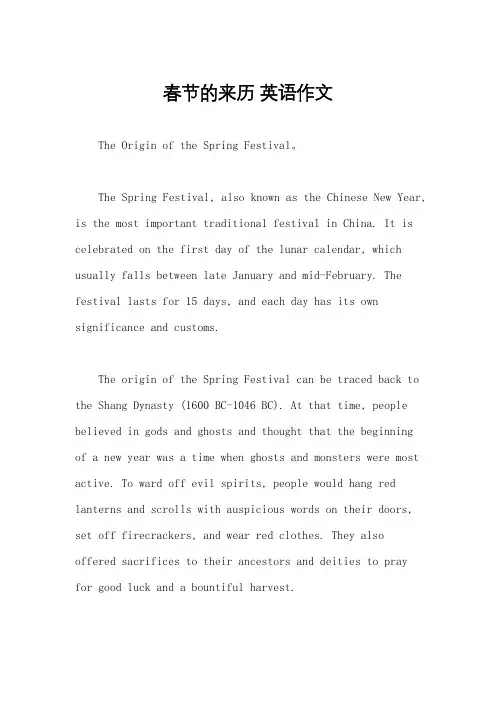
春节的来历英语作文The Origin of the Spring Festival。
The Spring Festival, also known as the Chinese New Year, is the most important traditional festival in China. It is celebrated on the first day of the lunar calendar, which usually falls between late January and mid-February. The festival lasts for 15 days, and each day has its own significance and customs.The origin of the Spring Festival can be traced back to the Shang Dynasty (1600 BC-1046 BC). At that time, people believed in gods and ghosts and thought that the beginningof a new year was a time when ghosts and monsters were most active. To ward off evil spirits, people would hang red lanterns and scrolls with auspicious words on their doors, set off firecrackers, and wear red clothes. They alsooffered sacrifices to their ancestors and deities to prayfor good luck and a bountiful harvest.During the Qin Dynasty (221 BC-206 BC), the Spring Festival was officially designated as a national holiday.In the Han Dynasty (206 BC-220 AD), the festival becamemore elaborate, with various customs and traditions added, such as the dragon and lion dance, the lantern festival,and the exchange of red envelopes filled with money.Today, the Spring Festival is still celebrated withgreat enthusiasm and joy in China and other parts of the world where there are Chinese communities. People cleantheir houses, decorate them with red paper cutouts and couplets, and prepare special food for the occasion, suchas dumplings, fish, and rice cakes. They also visitrelatives and friends, give gifts, and watch the Spring Festival Gala on TV.In conclusion, the Spring Festival is not only a timefor family reunion and celebration, but also a reflectionof the rich cultural heritage of China. It has been passed down from generation to generation and will continue to be an important part of Chinese culture for many years to come.。
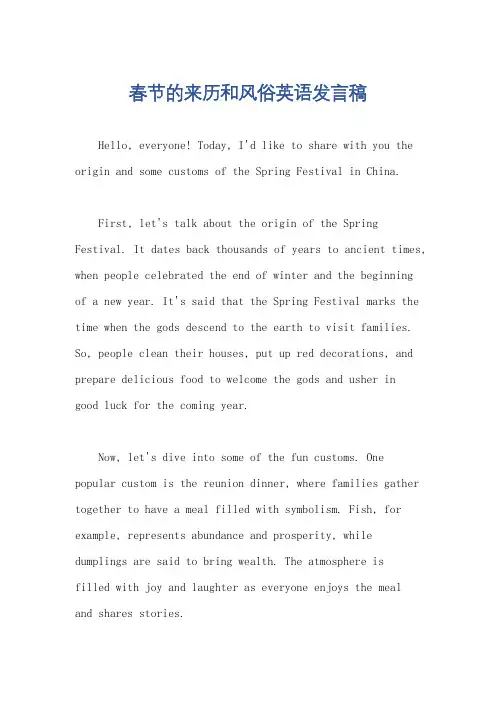
春节的来历和风俗英语发言稿Hello, everyone! Today, I'd like to share with you the origin and some customs of the Spring Festival in China.First, let's talk about the origin of the Spring Festival. It dates back thousands of years to ancient times, when people celebrated the end of winter and the beginningof a new year. It's said that the Spring Festival marks the time when the gods descend to the earth to visit families. So, people clean their houses, put up red decorations, and prepare delicious food to welcome the gods and usher ingood luck for the coming year.Now, let's dive into some of the fun customs. One popular custom is the reunion dinner, where families gather together to have a meal filled with symbolism. Fish, for example, represents abundance and prosperity, while dumplings are said to bring wealth. The atmosphere isfilled with joy and laughter as everyone enjoys the mealand shares stories.Another exciting custom is the red envelope, or "hongbao" in Chinese. On the eve of the Spring Festival, elders give.。
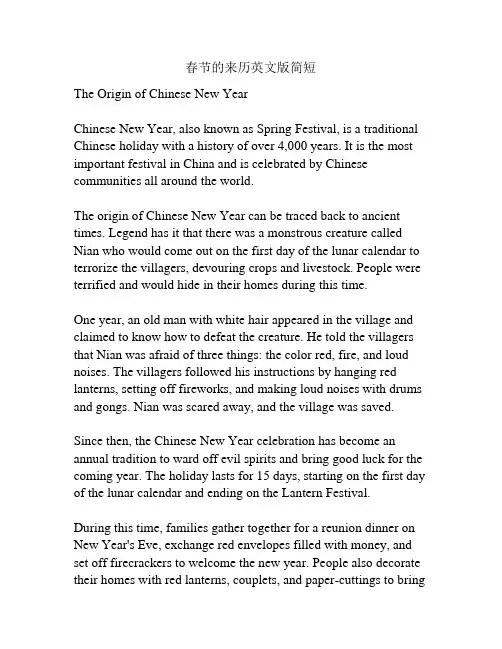
春节的来历英文版简短The Origin of Chinese New YearChinese New Year, also known as Spring Festival, is a traditional Chinese holiday with a history of over 4,000 years. It is the most important festival in China and is celebrated by Chinese communities all around the world.The origin of Chinese New Year can be traced back to ancient times. Legend has it that there was a monstrous creature called Nian who would come out on the first day of the lunar calendar to terrorize the villagers, devouring crops and livestock. People were terrified and would hide in their homes during this time.One year, an old man with white hair appeared in the village and claimed to know how to defeat the creature. He told the villagers that Nian was afraid of three things: the color red, fire, and loud noises. The villagers followed his instructions by hanging red lanterns, setting off fireworks, and making loud noises with drums and gongs. Nian was scared away, and the village was saved.Since then, the Chinese New Year celebration has become an annual tradition to ward off evil spirits and bring good luck for the coming year. The holiday lasts for 15 days, starting on the first day of the lunar calendar and ending on the Lantern Festival.During this time, families gather together for a reunion dinner on New Year's Eve, exchange red envelopes filled with money, and set off firecrackers to welcome the new year. People also decorate their homes with red lanterns, couplets, and paper-cuttings to bringgood fortune.Chinese New Year is also a time for cultural performances, such as lion dances, dragon dances, and traditional Chinese opera. The streets are filled with bustling markets selling traditional snacks, decorations, and gifts.The festival not only promotes family togetherness but also allows people to pay respects to ancestors and pray for a prosperous year ahead. It is a time of joy, unity, and rich cultural traditions for the Chinese people.In conclusion, Chinese New Year is a festival deeply rooted in ancient myths and traditions. It is a time to celebrate and renew hopes for a prosperous and lucky year ahead while honoring the rich cultural heritage of China.。
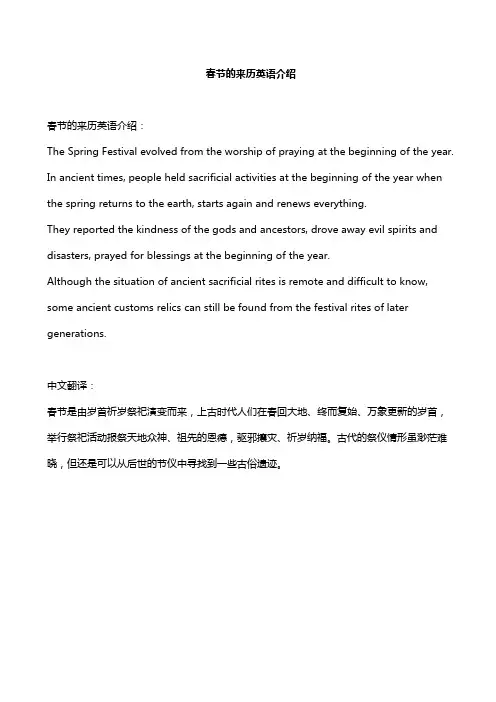
春节的来历英语介绍
春节的来历英语介绍:
The Spring Festival evolved from the worship of praying at the beginning of the year.
In ancient times, people held sacrificial activities at the beginning of the year when
the spring returns to the earth, starts again and renews everything.
They reported the kindness of the gods and ancestors, drove away evil spirits and
disasters, prayed for blessings at the beginning of the year.
Although the situation of ancient sacrificial rites is remote and difficult to know,
some ancient customs relics can still be found from the festival rites of later
generations.
中文翻译:
春节是由岁首祈岁祭祀演变而来,上古时代人们在春回大地、终而复始、万象更新的岁首,
举行祭祀活动报祭天地众神、祖先的恩德,驱邪攘灾、祈岁纳福。古代的祭仪情形虽渺茫难
晓,但还是可以从后世的节仪中寻找到一些古俗遗迹。
The Spring Festival
The Spring Festival is known as the most famous and important festival
in China. The lunar calendar new year origin, has the basis, also is rich
and picks the varied fable to be possible to trace to several millenniums
before; Most is famous is "the year beast" fable. "The year beast" is a
cruel terrible wild animal, ancient times the person believed "year beast"
when lunar New Year's Eve night can come out eats the person. The fable
"the year beast" extremely fears red, the flame and quarrels the mixed
sound, the people on paste the red paper in the gate, and selects the torch
all night, is setting off the artillery candle, avoids "the year beast". To
second day early morning, "has congratulated" the sound to the ear, in the
air does not fill the air is defeating "the year beast" the victory and the
rebirth joy.
The Spring Festival is the most important festival for the Chinese
people and is when all family members get together, just like Christmas
in the West. All people living away from home go back, becoming the
busiest time for transportation systems of about half a month from the
Spring Festival. Airports, railway stations and long-distance bus stations
are crowded with home returnees.
Many customs accompany the Spring Festival. Some are still followed
today, but others have weakened. People attach great importance to
Spring Festival Eve. At that time, all family members eat dinner together.
The meal is more luxurious than usual. Dishes such as chicken, fish and
bean curd cannot be excluded, for in Chinese, their pronunciations,
respectively "ji", "yu" and "doufu," mean auspiciousness, abundance and
richness. After the dinner, the whole family will sit together, chatting and
watching TV. In recent years, the Spring Festival party broadcast on
China Central Television Station (CCTV) is essential entertainment for
the Chinese both at home and abroad. According to custom, each family
will stay up to see the New Year in.
Waking up on New Year, everybody dresses up. First they extend
greetings to their parents. Then each child will get money as a New Year
gift, wrapped up in red paper. People in northern China will eat
jiaozi, or dumplings, for breakfast, as they think "jiaozi" in sound means
"bidding farewell to the old and ushering in the new". Also, the shape of
the dumpling is like gold ingot from ancient China. So people eat them
and wish for money and treasure. The first five days after the Spring
Festival are a good time for relatives, friends, and classmates as well as
colleagues to exchange greetings, gifts and chat leisurely.
Burning fireworks was once the most typical custom on the Spring
Festival. People thought the spluttering sound could help drive away evil
spirits. However, such an activity was completely or partially forbidden
in big cities once the government took security, noise and pollution
factors into consideration. As a replacement, some buy tapes with
firecracker sounds to listen to, some break little balloons to get the sound
too, while others buy firecracker handicrafts to hang in the living room.
The lively atmosphere not only fills every household, but permeates to
streets and lanes. A series of activities such as lion dancing, dragon
lantern dancing, lantern festivals and temple fairs will be held for days.
The Spring Festival then comes to an end when the Lantern Festival is
finished.
China has 56 ethnic groups. Minorities celebrate their Spring Festival
almost the same day as the Han people, and they have different customs.